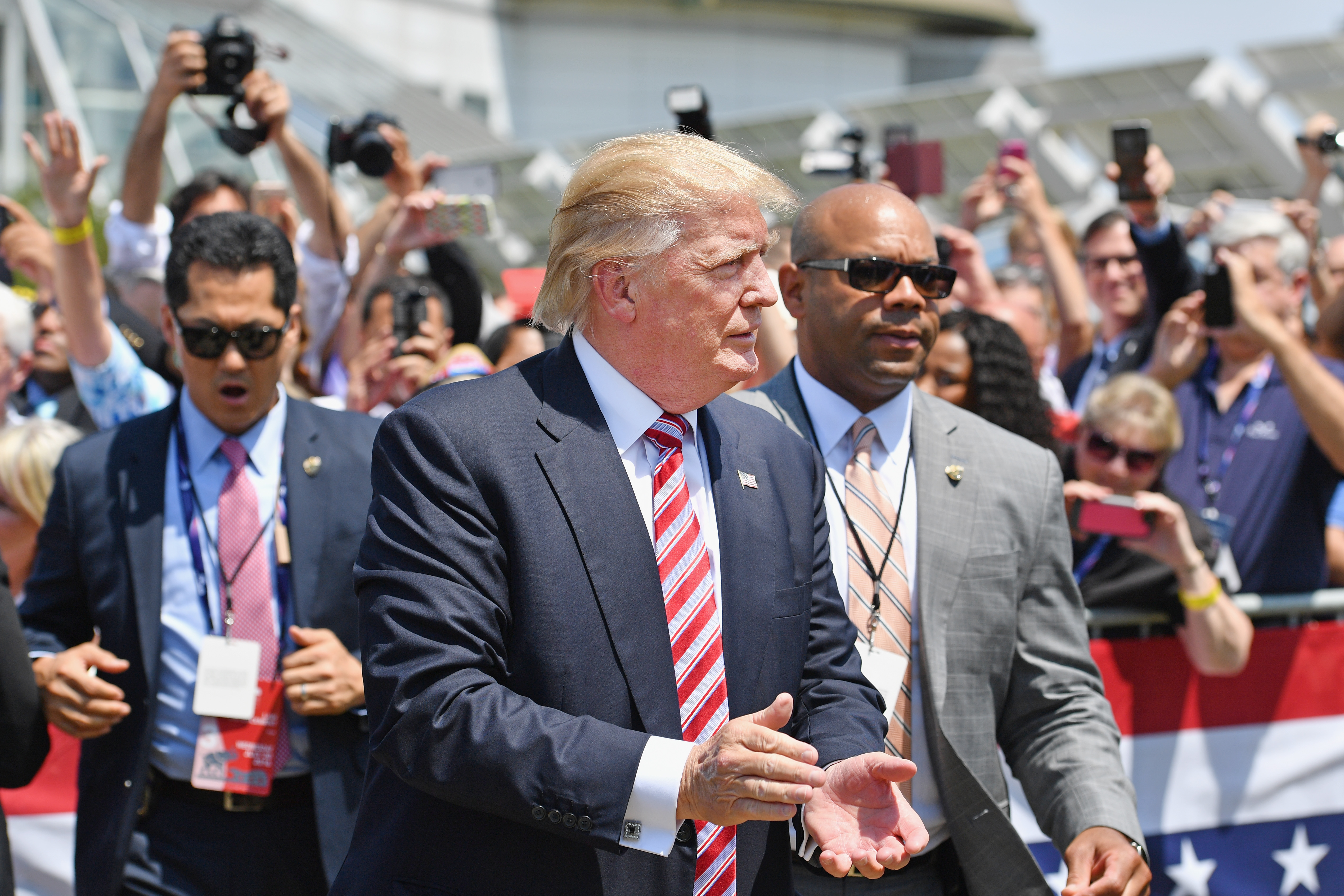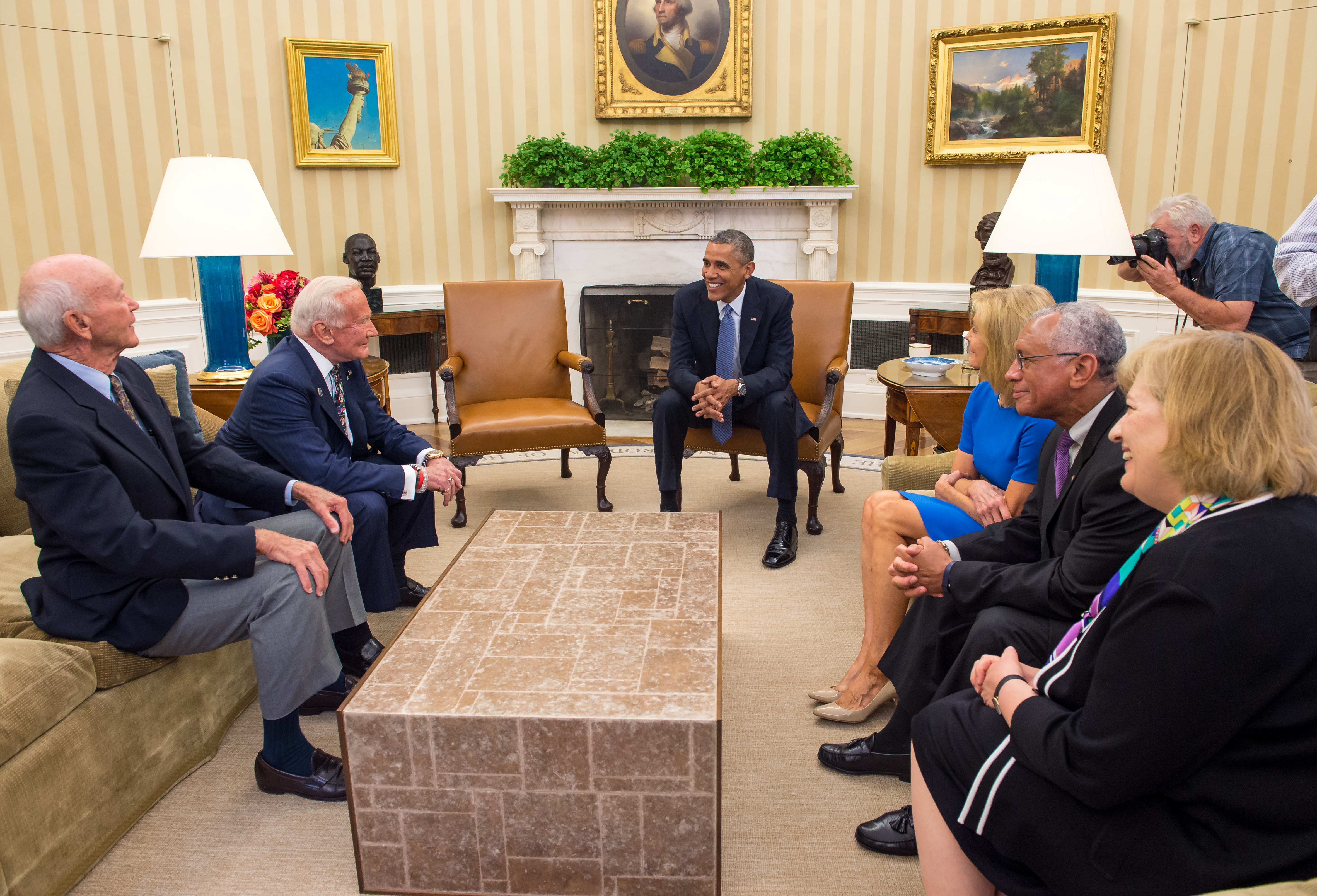US Presidential Transition and Space: Experts Forecast Changes to Come

GRAPEVINE, Texas — A new presidential administration always brings changes for the U.S. space science and spaceflight communities. So what does the current transition period reveal about how the new administration will handle science and space? A panel of space policy experts here at the 229th meeting of the American Astronomical Society gathered to discuss the possibilities.
During the panel session, the speakers focused on the state of the presidential transition, including the arrival of a "landing team" at NASA that is helping the agency move over to the new administration. The panel also covered what space policies President-elect Trump might support, as well as how members of the science community can best get involved in the political processes that affect them.
The space science and spaceflight communities both receive significant amounts of funding from the federal government, primarily from NASA, the National Science Foundation (NSF) and the Department of Energy (DOE). The president is typically responsible for appointing the top leaders to those agencies (although Congress must confirm those appointments). The president also proposes a national budget that includes allocated funds for those agencies, and he or she can influence major programs within agencies like NASA, as was the case with President Obama and the ill-fated human spaceflight program, Constellation. [The Future of Space: Top Issues Facing President-Elect Donald Trump]
Here are some of the topics the panel speakers covered.
Building trust
The Trump transition team has sent "landing teams" to some government agencies, including NASA and the DOE "to provide guidance to people higher up in the transition team," said Jeff Foust, a senior writer at SpaceNews (which is syndicated by Space.com), who spoke at the session. The landing teams also "identify issues that [the transition team] needs to address — near-term issues or issues that can be held off toward the longer term — so that [the transition team] can prioritize accordingly," Foust said, but noted that the landing team members are not filling official roles and cannot set policies for those agencies.
NASA received a "rather large" landing team of eight people, all of whom have worked for or with the agency in some capacity, Foust said. That means the current staff members at the agency "can skip the 'NASA 101' lesson and dive right into a lot of the details" of various programs, he said. In addition, some of the landing team members have experience in commercial space endeavors.
The NASA landing team is being led by Chris Shank, who worked for NASA from 2005 to 2009, and worked for House Science Committee Chairman Lamar Smith (R-Texas) up until December 2016.
Breaking space news, the latest updates on rocket launches, skywatching events and more!
"So [Shank] has got both experience with NASA as a bureaucracy and as an agency," Rick Mertens, associate director for the Office of Federal Relations for the Texas A&M University System, said during the session at AAS.
Mertens added that, in his opinion, the landing teams are also responsible for sowing trust between the staff members at the agency and the new administration.
"When you have a president elect [and] a new administration that's coming in with significantly different policies than the previous one, there's going to be a great deal of distrust, I believe," Mertens said. "And it's a challenge, or it can be a challenge, to earn that trust in the 73 days that you have to put together all the transitions."
The NASA landing team also includes former NASA astronaut Sandra Magnus, who flew to space three times (her most recent trip was in July 2011) and spent 4.5 months on the International Space Station. She has been executive director of the American Institute of Aeronautics and Astronautics since 2012. Also on the team is Steve Cook, who was in charge of the Ares 1 and Ares 5 rocket programs at NASA's Marshall Space Flight Center in Huntsville, Alabama. President Obama canceled the Areas program, but the rocket designs were folded into the heavy-lift rocket that NASA is currently building, called the Space Launch System (SLS). Cook left NASA in 2009 to work for Dynetics, a private aeronautics company in Huntsville.
Foust cautioned against inferring anything about the Trump administration's preferences on NASA policies or programs based on the opinions of the landing-team members; in the past, some of the team members have publicly expressed strong opinions about particular NASA programs or policies.
"Just because you see someone [is] on the landing team doesn't necessarily mean that he or she is there because the administration wants to go in a particular direction," Foust said. "That formal landing-team process will be wrapping up in a couple of weeks, even though some [of the landing team members] may stay on board just temporarily in critical point positions."
No landing team has been assigned to the NSF, which the panelists said has left them feeling even more unsure about the administration's plans for that agency.
Leadership positions
Foust said the most common question he's been asked recently is, "Who will be the next NASA administrator?"

"The short answer is I don't know," Foust said. What's more, it could be months before the Trump administration makes a selection — as was the case with the Obama administration's nomination of former NASA astronaut Charlie Bolden — and it may then take additional months before the Senate confirms that nominee. Bolden will step down from the position before February, and until a new administrator is appointed, NASA Associate Administrator Robert Lightfoot will stand in as acting administrator. The new president will also nominate a deputy administrator, a role currently filled by MIT aeronautics engineer Dava Newman, who will also step down.
The director of the NSF is appointed on a six-year cycle, and the current director, France Córdova, was appointed in 2014. Cordova has not announced plans to step down from that position.
The new administration has nominated former Texas Gov. Rick Perry to lead the DOE. That agency invests in many astrophysics-related projects, mainly those with a nuclear physics or high-energy physics focus, such as the Fermi Gamma-ray Space Telescope and the camera for the Large Synoptic Survey Telescope.
"The DOE's a very interesting agency," said Mertens. "It's not necessarily an energy policy agency, although there are certainly energy policy pieces to it. There's a great deal of nuclear policy associated with it, and it has a very strong science base to it as well. Gov. Perry doesn't necessarily have a background in those components of it, so [his nomination] is a little bit different than the pick for the DOE secretary in the past, where they've been scientists."
President-elect Trump has not nominated anyone to lead the White House Office of Science and Technology Policy. The leader of that office is frequently referred to as the president's science advisor. Mertens said he has heard rumors that Trump won't appoint anyone to the position.
"That remains to be seen," Mertens said. "But it can be a very critical position, not only in helping set policy in the science area for the next president, but [also in having] … someone that is a point person to explain [to the president] how they're handling science within the administration."
Mertens said John Marburger, science adviser to President George W. Bush, was a "very vocal point person" who was able to explain to the president the administration's policies affecting things like stem cell research and other "flash points," (topics that incite strong public opinion and/or deeply impact the scientific community).
"My guess is there will be similar 'flash points' in this administration," Marburger said. "And having someone who can be your point person to explain those things, to my mind, would be good for the next administration to have. Who that person will be, if they select someone, will be a good indicator [of] where this administration is in terms of science." [Playing the Space Trump Card: Relaunching a National Space Council]
Policies, budgets and the future of Earth science
The president is responsible for submitting a proposed budget to Congress, which then reviews the budget, makes adjustments and ultimately votes on a final budget. (The most recent Congress, however, failed to pass a budget, which means the country is now working on an extension of the fiscal year 2016 budget.)
Overall, Foust said, it's unlikely that the new administration will spell major changes for astronomy, astrophysics or most of the related disciplines.

"In the short term, I don't expect to see major changes, particularly for the areas like astrophysics [and] planetary science. ... These are not high-profile issues," Foust said. He added that there are no "driving concerns" related to federally funded astronomy and astrophysics programs.
"Given that, for example, [the James Web Space Telescope] is making good progress [and the Wide Field Infrared Survey Telescope] is getting up to speed, [the big programs] don't have a lot of red flags associated with them that say [to the new administration], 'Hey, this needs immediate attention.'"
Foust said he thinks the fiscal year 2019 budget will be the first federal budget "that will have a serious imprint of the new administration on NASA, on the NSF, on other agencies, simply because it's going to be the one [the administration has] had time to devote the most attention to."
Mertens said he expected a "tight" funding situation for all federally funded research, and that research programs focusing on climate change science, Earth science and renewable energy "are going to be looked at very closely" by the new administration, and by the Republican-controlled senate.
The possibility that the Trump administration and the Republican-controlled Congress will try to eliminate or reduce NASA's Earth science program has been in the air for years (in the case of Congress) and months (in the case of Trump's campaign). In an op-ed for SpaceNews published on Oct. 19, Robert S. Walker and Peter Navarro, who acted as advisors to the Trump campaign, said that "NASA should be focused primarily on deep-space activities rather than Earth-centric work that is better handled by other agencies."
Republican senators, including Sen. Ted Cruz (R-Texas), chairman of the Senate space subcommittee, have questioned NASA's emphasis on Earth science. In 2015, Rep. Smith sponsored a bill that would have shifted money away from NASA's Earth science program. The agency has defended its Earth science program to Congress.
Members of the space science community who are concerned about the future of NASA's Earth science program should perhaps follow the advice of "The Hitchhiker's Guide to the Galaxy" — "don't panic!", said Mark Mozena, who worked on issues relating to science and technology in the office of Congressman Mike Honda (D-Calif.) up until the end of Honda's term earlier this month.
Mozena said the science community should certainly be wary of any attempt to remove Earth science from NASA and pass that work to another agency (most likely the National Oceanic and Atmospheric Administration).
"That would be a wolf in sheep's clothing," Mozena said. "I strongly recommend you all interpret that as equal to a cut in Earth science, because putting those programs into NOAA would be a death sentence long term. NOAA does not have the ability to support it, and the money would not necessarily come with it."
But such a large change to NASA's program would take time and would not come from a single executive order. Instead, it would likely first arise in the legislature through an appropriations committee, Mozena said. He cautioned against the type of action that could "create the problem we're afraid of.
"We definitely don't need to be writing op-eds about '[how Republicans are] anti-Earth science' or 'They're attacking Earth science.'" he said. "I think we need to be vigilant, we need to pay attention, we need to be ready as a community to stand strong with Earth science."
Congress and timing
Mozena emphasized the importance of timing when scientists reach out to Congress to discuss issues relevant to the space community.
"If you show up in August to talk about budget priorities with your member of Congress, that's lovely, but it's too late," he said. "So you should figure out when would be the best time to be coming to the Hill. That's your leverage arm, and it's very important to be on time." The best time for a scientist to contact a representative can depend on what exactly the scientist is trying to influence, such as a budget item or a piece of legislation. Many science member societies including the AAS, have staff members who can help scientists figure out when to contact a particular representative on a particular issue.

The other panelists also emphasized that the space community should remember that members of Congress will influence science agencies perhaps more deeply than the president does. The Senate Appropriations Committee, which is responsible for drafting budgets for agencies including NASA, is staffed by senators with interests in particular NASA missions, Mozena said.
"Senator [Richard] Shelby [R-Alabama] is very interested in big rockets. So the SLS is not going anywhere if senator Shelby has a heartbeat," he said. "Senator Culberson out of Texas, he is very interested in planetary science, so we're going to [Jupiter's moon] Europa. So with the transition process, keep in mind it involves the very real priorities of the already-existing, already-known Republican congressmen."
Mertens echoed that point, adding that considering the heavy role Congress will play in determining outcomes, "there might be more status quo than you might think."
Follow Calla Cofield @callacofield. Follow us @Spacedotcom, Facebook and Google+. Original article on Space.com.
Join our Space Forums to keep talking space on the latest missions, night sky and more! And if you have a news tip, correction or comment, let us know at: community@space.com.

Calla Cofield joined Space.com's crew in October 2014. She enjoys writing about black holes, exploding stars, ripples in space-time, science in comic books, and all the mysteries of the cosmos. Prior to joining Space.com Calla worked as a freelance writer, with her work appearing in APS News, Symmetry magazine, Scientific American, Nature News, Physics World, and others. From 2010 to 2014 she was a producer for The Physics Central Podcast. Previously, Calla worked at the American Museum of Natural History in New York City (hands down the best office building ever) and SLAC National Accelerator Laboratory in California. Calla studied physics at the University of Massachusetts, Amherst and is originally from Sandy, Utah. In 2018, Calla left Space.com to join NASA's Jet Propulsion Laboratory media team where she oversees astronomy, physics, exoplanets and the Cold Atom Lab mission. She has been underground at three of the largest particle accelerators in the world and would really like to know what the heck dark matter is. Contact Calla via: E-Mail – Twitter
